The Thrill of a Lifetime |
Read more at in70mm.com The 70mm Newsletter |
| Written by: Betty York, Sarasota, Florida, USA | Date: 01.01.2017 |
Prologue |
|
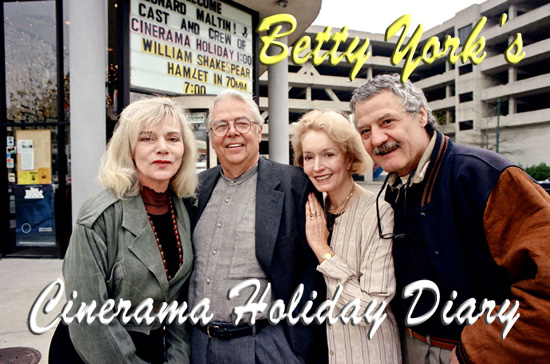 Beatrice, John, Betty
and Fred in Dayton, Ohio, May 1997 for the "Cinerama Holiday" reunion
party. Picture by Thomas Hauerslev Beatrice, John, Betty
and Fred in Dayton, Ohio, May 1997 for the "Cinerama Holiday" reunion
party. Picture by Thomas Hauerslev“Cinerama Holiday” (Premiere New York, 8. February 1955) (Producer Louis de Rochemont) is the second of Cinerama’s five original travelogues. The filming of this movie tried to push the limits of the bulky Cinerama camera as the movie is finally projected onto a 146-degree curved screen to produce a large super-sharp image with outstanding directional sound - an effect that is often likened to the present day IMAX process. Yet, “Cinerama Holiday” is no boring travelogue. Instead it follows the adventures of two couples in 1954 when international travel was still prohibitively expensive for most Americans. Thus, in the movie, the cameras follow the adventures of two typical young couples – John and Betty Marsh from Kansas City in Europe and Fred and Beatrice Troller from Zurich in America – namely, the Marshes as they fly over the Swiss Alps and visit St. Moritz, travel to Paris where they visit the Louvre, visit with Art Buchwald, see an Opera performance at l’Opera de Paris, and visit the Lido nightclub, then returning to America via New York. Meanwhile the Trollers visit Las Vegas, ride the California Zephyr through the Rockies, visit New Orleans and go to a traditional New England Fair. The following sections are excerpts from the diary of Betty Marsh as she records in refreshing naivete her daily impressions of her new experiences, which were not recorded on camera. The diary excerpts are collected under the following headings • Chapter 1: Kansas City to Zurich 4 • Chapter 2: Zurich • Chapter 3: Paris • Chapter 4: Switzerland • Chapter 5: Italy • Chapter 6: Paris Again • Chapter 7: The Trip Home • Epilogue |
More in 70mm reading: • Betty York, A Mini Bio • The Cinerama page • Cinerama Remaster • Flicker Alley presents CINERAMA HOLIDAY • Cinerama Afterglow - A Get Together in Dayton, OH • California Zephyr and Cinerama Holiday Internet link: Production Date: Dec 1953 and Feb--May 1954 New York Times Review afi.com |
Chapter 1: Kansas City to Zurich |
|
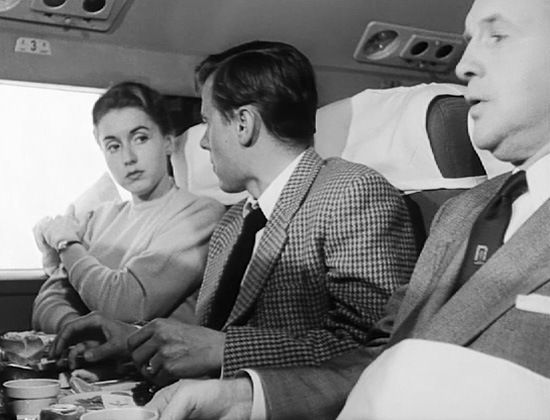 Frame
grab from "Cinerama Holiday" prologue. Picture: Cinerama Inc. Frame
grab from "Cinerama Holiday" prologue. Picture: Cinerama Inc.Left KC for New York Friday Morning at 8:30. Felt terribly depressed at being away so long from people who had been so wonderful to us, especially in the last few days. Almost cried as they all waved Good Bye to us. NEW YORK: Friday afternoon was a beautiful clear day when we arrived. Was amazed at the extra height and the narrowness of even the houses. They looked so tall and skinny especially from the air. Manhattan looked Just as I expected, but I was still amazed at the number of tall buildings crammed so close together. Borden Mace, president of Durochement Associates and Lou Boase who met us were very sweet and kind, and took us to the Forest Hills Inn. First taxi driver, also first New Yorker we met was very rude. He almost would not take us because it was a short trip. We were not allowed to visit New York – that had to wait until a month later. Had dinner in our ‘suite’ with the above men, and Lynn Farnell and Harry Goldberg. Had red roses in our room when we arrived. Had my first Eastern Lobster – superb. Friends from K.C. now living in NYC visited us later and treated us to a bottle of champagne. We all talked about the fairy tale quality of it all and speculated about our future; if it will be unchanged or as impossibly different as some people think it might. Outside of the trip itself we are thrilled at the thought our salary will go towards a house, which we would love. Saturday Morning: Had breakfast and were astonished at being insultingly treated by a waiter, who had no cause what-so-ever. Went shopping in the neighbourhood, noticed the different way of speech and that all the women pushed little carts to carry their packages. Went to Idlewild (which J. insists on calling Idleworld) and found our luggage was misplaced. All the Swiss Air personel buzzed about us like bees after honey being very solicitous and quite friendly. We were put on board first, thus avoiding all the usual standing around and red tape. We took off into a drizzly and grey sky and were soon enveloped by clouds. Had a meal on the plane at 4 or 5 starting with wine and hors d`oeuvres (enough to be a full size luncheon for me) then chicken in mushroom sauce, beans, potatoes and lemon meringue pie, plus candies, cheese, fruits, everything. Enough food for an army! We could see the hostesses in their ‘kitchen’ and were amazed at the quantity of food they pulled out of nowhere. Next drinks and wines came out of faucets in the wall like water at a soda fountain. Flight to Europe Landed in Gander [Canada], where our berths were made up and I found Nanse Poo had been tucked in by the steward. We got a large charge out of changing into pyjamas in such tight quarters- me with all my crinolines to wiggle out of. But we accomplished that and slept well. We had lost 6 hours so were up at 4 a.m. really instead at 10 a.m. Our first glimpse of Ireland was that it was very green for winter and very quaint. The farms were so picturesque with their thatched roofs and some clay roofs with grass growing on them. We saw 2 castles near Shannon. Imagine – real castles. Frankfurt by Saturday afternoon: Got to coughing and could not eat lunch. Then got horribly sick on the plane before Zurich and could not get off for ten minutes or so. |
|
Chapter 2: Zurich |
|
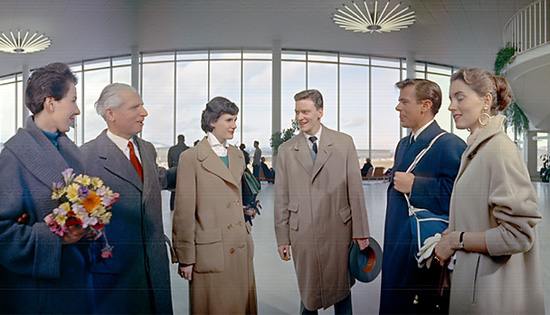 Swiss
Air representatives welcoming John and Betty Marsh to Switzerland. Frame
grab from "Cinerama Holiday". Picture: Cinerama Inc. Swiss
Air representatives welcoming John and Betty Marsh to Switzerland. Frame
grab from "Cinerama Holiday". Picture: Cinerama Inc.We were overwhelmed by the welcoming committee – Swiss Air representatives, the head of the Swiss Tourist Office, his wife and daughter who thrusted a bouquet of mimosas and carnations and a box of chocolates into my hands and kissed me on both cheeks, all the while welcoming us to Switzerland. Peter Hopkinson, a BR representative was also there and took us to the Baurau Lac Hotel where we were to stay over-night because we had missed our plane to Paris. Our room was beautiful with a lovely view of the lake and snow covered trees. The furniture was sort of direcoire period and the beds were twin ones pushed together. The bathroom was as gleaming and sterile looking as a hospital with two of everything except a tub, which was not necessary because it was big enough to accommodate two people easily. The faucets for the tub came from a half-way point on the side rather than the end, as at home. The bathroom itself was about 6 or 7 feet wide and about 18 feet long. It stretched on and on. The hotel itself, 100 years old, had beautiful stained glass windows off the center hall and marble topped period pieces everywhere. In the first floor lounge were many identical little round marble topped tables (for tea time), with chairs drawn close, and on every piece of furniture that would accommodate them were tiny vases holding miniature bouquets of flours. Such a friendly, inviting touch, and the more so in the dead of winter. The management sent up a small basket of delicious assorted fruits, the most unusual to us being the “blood” oranges which have red juice, and a different and delicious flavor. |
|
 John
and Betty Marsh with Beatrice and Fred Troller with the Cinerama camera crew
to the right. Picture: Cinerama Inc. John
and Betty Marsh with Beatrice and Fred Troller with the Cinerama camera crew
to the right. Picture: Cinerama Inc.We met our Swiss counterparts and are sure if we aren’t typical neither are they. They were perfectly charming. She looks a good deal like Ingrid Bergman, with fresh outdoors-ish type beauty and a wonderfully rich voice. He resembles Cornel Wilde as he played Chopin, only his build is smaller than Wilde. Fred looks slightly Latin with slender, delicate features & Beatrice looks more Scandinavian or Swedish. We went to eat at the Dezaley with them and had delicious cheese fondue, followed by, rather than accompanying, a green salad. We had grape juice rather than wine because we aren’t used to it and get quite groggy after a little glass of it. Back to the hotel; to bed at 12:00 and we slept round the clock to 11:20. The beds (or bed, since one is enough for us) were very comfortable. The sheets were of crisply-ironed linen beautifully done up, and the pillows square, with a flange pillowcase, two to a bed. For covers, we had a great thick down comforter. The pillows also were down filled so it’s no wonder we slept like babes. Down the next morning we posed for more pictures with Fred and Bea and then with Peter we went to luncheon with the Neiderers to the Victoria, a very special quaint restaurant type like one of those in the Swiss cantons. The waitresses wore local peasant costumes - very colorful. So many of the little things in the restaurants, black hammered-iron wall lamps, wooden wagon wheel chandeliers, etc., looked either Western or Early American, that it was sometimes hard to believe we were in Europe. Zurich was our first European city. I was pleased to see beautiful wrought iron balconies and shuttered windows almost everywhere. Some of the streets are too narrow for cars and are like alleys opening off wider thoroughfares. The city itself is extremely clean, like all Swiss cities, so we’ve heard. French and German is spoken everywhere with most people speaking both fluently, with a good knowledge of English also. My first encounter with the language was in Gander where I heard a woman cooing and talking to her baby in German. It not only seemed so strange that mother-talk had the same tones of tenderness in both languages, but for a moment I caught myself thinking “my, what a smart baby to understand German.” I nearly died laughing at myself when I realized how ridiculous this is. I can’t get over being amazed (this I know is silly) at the people I see dressed like Americans and with features and coloring one might see in any American city but who speak an incomprehensible language. When one sees a Mexican or a Chinaman, whose coloring and features do differ from the average “melting pot American,” one would expect them to talk differently. But only when I see a person with clothes that aren’t like ours like the Frenchmen with berets, or the great number of European men (and not necessarily poor ones) who have needed a haircut for a month, only then do I feel they are at home speaking another language. This must be a very provincial opinion but probably typical of one who has done very little traveling. |
|
Chapter 3: Paris |
|
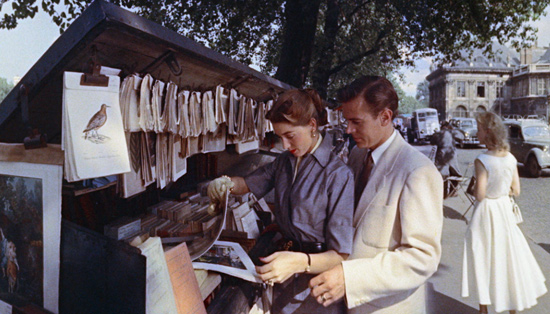 Paris
in Cinerama. Frame grab from "Cinerama Holiday". Picture: Cinerama Inc. Paris
in Cinerama. Frame grab from "Cinerama Holiday". Picture: Cinerama Inc.Monday afternoon: Off to Paris. The last lap and the dreaded one for we were to meet De Rochemont himself and the frightening consideration he might not like us and might send us home. We were met by Andy S. and John Walsh at a huge, dimly lit and very dismal airport. It’s hard getting used to checking passports before entering barred doors yet it fills you with pride when an American passport gets checked through in a matter of seconds, while other people are kept waiting for ok’s. A taxi took the four of us plus Kryn Tacomis the cameraman from Magnum Photos through Paris to the Pont Royal Hotel on the Left Bank. The whole city was shrouded in haze, and at 5:30 p.m. it was already dark. Our first look at “the greatest city in the world” was of one of the lesser attractive sections, which seemed to be covered with the dirt and smoke of centuries and probably were. People on bicycles everywhere seemed to add danger to the trip but not nearly as much as the fact that the taxi drivers drive with only the parking lights on. Only on occasion will they turn on their lights and then only for a moment. Maybe they’re conserving the battery. From the windows of our room we can look up the Rue de Bac and see the taxis flicking their lights on and off as they do when they pass or meet another car on the dimly lit streets, which reminds me of so many fireflies in the night. |
|
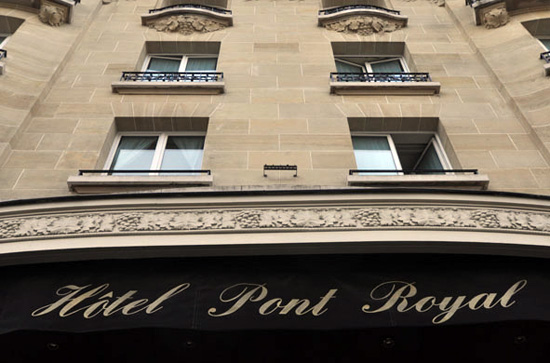 Hotel
Pont Royal in Paris. Picture by Thomas Hauerslev Hotel
Pont Royal in Paris. Picture by Thomas HauerslevThe first sound of Paris that we became aware of was the same taxi horns Gershwin based his "American in Paris" on. All the horns sound so funny. Even on the 12th of January [1954], Christmas is still hanging on with trees and tinsel seen occasionally in restaurants and stores. We finally met the great man himself - De Rochemont. We were both so scared we felt like dolts and could hardly speak. After all, what can one say to a person so great as he must be to produce the fine movies which we have seen. Andy and John took us out to dinner - our first in Paris and most typical of the kind an arty or student bunch would patronize. Like the Dezaley in Zurich, it has two floors. A few eat downstairs while others climb vertical spiral stairs to a little room upstairs. We got our first taste of real french bread which is sometimes over a yard long, and 1 1/2 “ in diameter, but always very good & chewy. We learned these were called “baguettes.” Butter is never served unless asked for and then is quite expensive. It also is unsalted, which seems flat to our American tongues. I ordered an artichoke for an hors d’oeurvres, the first we ever tackled, and kept eating the wrong part. When I got to the end where the heart is to be uncovered, I took a big bite of the spiny milkweed-like substance covering it. We all had a good laugh at that. This was followed by a kind of sausage for me and roast veal for Johnny and lots of little green navy beans for both. Andy nearly turned my stomach by eating a dish which is nothing more than raw hamburger and raw egg mixed together. I couldn’t look at it much less taste it. For dessert, chocolate mousse. Afterwards we walked to the Cafe de Deux Magots for coffee and then back to the hotel. The colors in the cafe where we ate were very gay and some nice oils were on the walls. Above each table hung a tiny balcony scene. Johnny has noticed that a white shirt is practically extinct in Paris, even on what appears to be a well-dressed businessman and he spotted no bright colors on the women at all, such as a scarf or gloves, etc. Only grays, blacks, and browns for the majority. From just walking in several sections of town I would say a smartly dressed woman is a scarcity, even in the better shopping district, yet clothes in general do resemble our fashions. It’s the lack of accessories that make the difference, I think. First dog I saw in Paris was of all things, a French Poodle. He belonged to the proprietor of a dress shop. For breakfast we purchased an orange from a fruit market on the street right out in the open, but a better orange was never found anywhere stateside. Their skins are thick like a Sunkist but with a much better flavor. They are imported from Spain and North Africa. California has to go some to equal them. Pineapple is superb - pears also - green beans skinny. Parisian buildings in general seem to be huge; not in height but in depth and also width since one building might amble on for a block or more with the same facade. And the windows are almost without exception full length and open like doors onto tiny balconies, elaborately railed in iron of many ornate patterns. From the top of one building, our hotel room for instance, one can see the garret rooms with their big skylight windows which comprise the top floor or roof floor. In just such apartments we can imagine artists of the past painting & living even as many do today: Rudolfo and Schoenard in La Boheme will seem more real to us now that we’ve seen the locale and exterior of the room we’ve seen previously only on a stage. |
|
 Le
Tour. Picture by Thomas Hauerslev Le
Tour. Picture by Thomas HauerslevBreakfast in Europe is almost non-existent as such but consists usually of coffee & a roll of some sort (croissant). But considering the huge meals they eat for lunch and dinner or dinner & supper - whichever it is - who would have room for more? Saw a good many landmarks today. Eiffel tower, a tall and graceful tower; the Arche de Triomphe which seems to be surrounded by the maddest traffic anywhere in the world & upon which Napoleon’s victories are engraved. We window-shopped along the Champs E’lysees and got an idea of some of Paris’s fashions. Few stores have window mannequins but have the clothes pinned back and padded inside to resemble the fashion figure to an extent. The mannequins that one does find occasionally are not even as attractive as we have in our shops. And though most stores and shop windows are pleasantly decorated in a simple yet artistic manner, those having mannequins are dull and stiff & awkward-looking. Our first ride on a subway was confusing at the beginning for people who are used to no subway much less one in which all the signs are in an unfamiliar language. However it is easy to catch on for the Paris metro is about the finest in the world and very quick. The interior is all white tile, spotlessly clean with advertisements adorning the walls in a very modern style. There are practically no seats on the trains and one stands all the way with only the crowds to keep you from falling. Paris is a city I think that must grow on you particularly at this time of the year. In the spring or summer any city is at its best and easy to love for its looks alone, but in the winter it would be superficial to love Paris at first sight. I feel it must grow on you; a process which takes longer when it is gray and drizzly with not even a glimpse of the sun. |
|
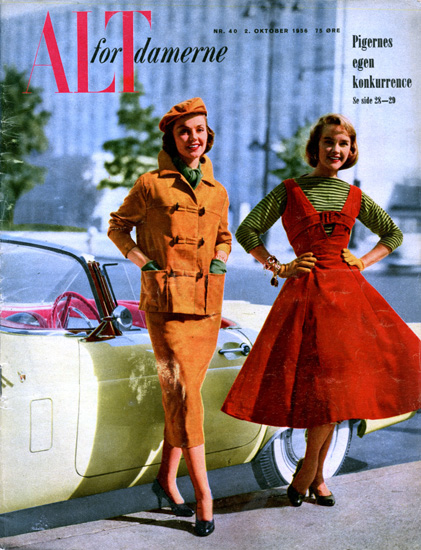 Contemporary
Danish fashion magazine, October 1956. Contemporary
Danish fashion magazine, October 1956.One of the most unusual and gratifying things about this city is its incomparable food. Even the tiniest cafes (and a good many hold very few people) put out food that would satisfy a discerning gourmet. The people take great pride in their food no matter how dumpy the restaurant itself. This is an idea that should catch on in the States. Coffee here is almost without exception as bad as the food is good. At least it seems so to an American palate. But one can forgive this when the rest of a meal is “par excellance.” Dinner tonight was in a restaurant serving food in the style of the southern part of France (Basque) and we ate with Louis Jr., Bob Bendick, the Director, and had the strolling violinist serenade me long and loud much to the delight of all. The restaurant was very charming and decorated with lots of copper in pieces similar to our Early American stuff. I’m always seeing little tables, chairs, baskets, bottles, wrought iron and all sorts of impossibly big things that I’d love to cart home to add a continental touch to our already slightly Bohemian apartment. Of all the advice we heard before we left, the two we’re most grateful for are the tips about bringing soap and good toilet tissue. Soap is not furnished in a lot of hotels and is comparatively hard to find in the stores and the latter article in even the finest luxury hotels is a quality on a par with what Life Magazine is printed on. You see very few children in Paris unless you go to the parks - for when they are not there, the parents keep them home and do not let them play on the sidewalks. And of course there are few home gardens in Paris, an enclosed courtyard taking the place of this. Among children we’ve seen we noticed that even those as young as 18 months (the boys) wear short pants and then long socks to the knees which certainly is not as warm as the way Americans dress their children. Boys up to 9 and 10 were seen with this same outfit and only a waist-length jacket over it for warmth. We still can’t get over never being offered water in a restaurant. In fact, not only must you ask for it, but nine times out of ten you must pay for it, too. This of course is bottled water, however tap water is pure enough to drink. I might add that we almost never get ice in the water unless the restaurant is an expensive one and then the chunk is a small one. As cold as the buildings are here, it’s easy to see they don’t need much ice. When you come in from the outdoors there’s little temperature change unless you sit on a register or near a radiator. Even this doesn’t help for very little heat comes out. Men and women both are always all bundled up. The men wear sweaters in addition to their jackets and coats, even with a tie and shirt. Women wear shoes that are a cross between a shoe and boot, having a built-up top to a little above the ankle. These shoes are usually flat-heeled, of suede or calf, loose at the top like our galoshes are. Fur coats are not uncommon but a good-looking one is. They are thick and bushy, like a fox coat is; never are they sheared or cut in a graceful fashion. Even a mouton lamb would look thin compared to the bulky coats here. Incidentally, none of the furs looks familiar. Driving in Paris is truly an adventure. Taxis are everywhere at every street corner always waiting for a fare but never driving around looking for one. However, when you want one during the dinner hour, it is impossible to find one. Only if you are going to the same part of town will they condescend to take you there. Unlike an American who’d be willing to wait a few more minutes to eat rather than lose a tip, they drop everything to go home to their waiting hot lunch. And when they drive, it’s all over the road, both lanes. They drive at any speed they want and weave in and out of the speeding traffic. All the foreign cars are so tiny compared to ours they don’t even look safe. European cars are made small because they are taxed on the basis of weight and besides that, gas is expensive. These cars have only two cylinders. Opera Tonight we went to the Opera to see our favorite La Traviata, massacred, and that is to our tastes anyway. The stage settings were stupendous, with no expense spared in the lavish use of draperies, velvet and gauze. And the costumes were beautiful and rich. But the singers were hammy and overly dramatic and stiff-gestured and terribly artificial. In no way at all did it compare with the Met version on tour which we had seen. Some of the most beautiful and important scenes were deleted from the original score, some parts sung completely differently. To top all this, it was hard to get used to hearing it in French when we are so familiar with the Italian. The building itself is incomparable. The architect and builders saw to it that no flat surface was left as such, and elaborate is hardly the word for it. The dome of the auditorium itself is lined with a painting of angels, cupids, etc., in various stages of undress, all floating around silhouetted against a blue sky. The perspective is phenomenal, for you see the figures exactly as you normally would if you were looking straight up. In a horseshoe shape encompassing the orchestra floor are the four rows of loges and balconies with each two seat-width elegantly separated from those on either side with red plush partitions. To enter the orchestra floor you must walk up steps as it is on a higher level than the lobby. |
|
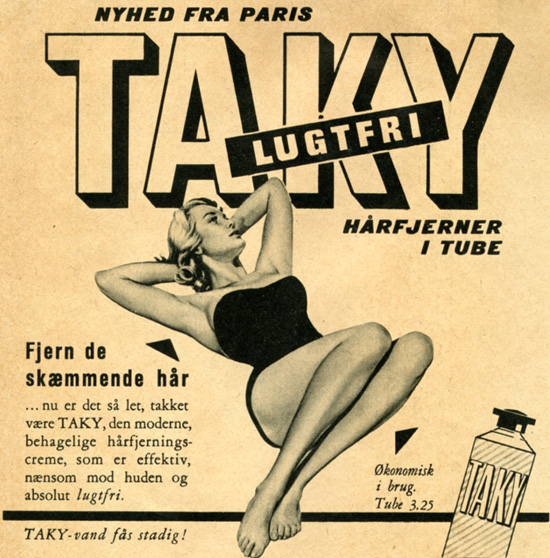 "American
model Jean Patchett, one of our top models in the US in the 50s. I never met
her or any of the other top gals but I always admired their photos and
probably learned a lot about posing from those pictures."
Betty York, 2016 "American
model Jean Patchett, one of our top models in the US in the 50s. I never met
her or any of the other top gals but I always admired their photos and
probably learned a lot about posing from those pictures."
Betty York, 2016"News From Paris. Taky hair removal". Contemporary Danish advertisement. The whole lobby or foyer is really flight-after-flight of curved marble stairs flanked with statues holding giant candelabra. Across the entire front of the building stretches an immense hall with windows overlooking the brightly-lit street, and more paintings on the ceiling. Here the people promenade during intermissions. To see and be seen is the thing, though why I don’t know, for very few people are dressed as one would expect of such an occasion and place. Standing about, adding atmosphere if nothing else, are uniformed gendarmes. When you are seated by an usher in either a movie or concert hall it is a must to tip. Just as you must pay for even a small printed program as well as paying for the use of restrooms even though there’s no attendant to hand you a towel. The exterior of the building resembles our capitol building only a great deal blacker from time. Lots of columns and a great, large dome in the middle. All around the building is an elaborate iron fence with more half-dressed statues of women intermittently spaced. Paris has more nude statues per sq. mile than any city in the U.S. I’m sure. A person who blushes at an undressed mannequin in a store window, as I do, would surely be miserable here where even the bridges across the Seine, (and there are some two dozen) are adorned with such statues. We visited the Jeu de Paume today - the museum of the Impressionist painters - and were again astonished by what we noticed at the Louvre. Priceless paintings hanging on walls in bare ugly rooms, some of which are not even lighted so you can see them. Two large murals by Toulouse L’autrec were hanging in just such a room, so dark it was impossible to even distinguish one color from another. Louvre I suppose the situation is better on a sunny day, but when does that miracle occur? Now, the Louvre is well-lighted, but again, these paintings of the masters, de Vinci, Michelangelo, El Greco, are hung as though they’re no more valuable than a student’s showing. They are not in small rooms off a main corridor as are the paintings in our own Nelson Gallery of Art, but are in rooms opening into the next and extending a block or more in this manner. It is possible to stand in the first room and look down through the rooms to see every painting on either side. The Louvre is cold except for an occasional register by which sits the guard for each room, all bundled up in shirt, sweater, vest and coat. The floors are not marble or mosaic, or even cork or attractive linoleum tile to help deaden sound, but are old, warped and stained oak floors. Maybe these famous works of art are capable of beautifying even the barn-like rooms of the Louvre, but any jewel is more beautiful when properly mounted and surely these “jewels” of art deserve the best. Tonight we tried our first French restaurant that specializes in American food. It is for homesick Americans who long for bacon & eggs, good coffee and even a hamburger. Well, it will be our last trip there. There was little or no ice cream in the malt, a tiny hamburger on a large, stale bun, and no mayonnaise to hold together a dry chicken salad sandwich. I guess the French are more at ease when they know what they’re doing very well, so we will eat French food from now on. Versailles We visited Versailles. Such splendor we’ve probably never seen before or will again. There were room after room, or salle after salle, with the walls literally covered with paintings from small size to gigantic. There must not have ever been an unemployment problem among artists of the past centuries. Some of the paintings we’ve seen must have taken years to complete, the battle scenes particularly, while the aristocracy must have done nothing but pose from babyhood on. The palais, though again black and dingy on the outside, is colorful and elegant inside. It stretches for blocks and blocks it seems, twisting this way- and- that, with gold leaf baroque decorations, great crystal chandeliers and marble of all colors everywhere. Most of the rooms were almost barren of furniture, and only a couple of rooms were furnished, those being the bed rooms where Louis XVI and Marie Antoinette lived. The floors were the most beautiful we’ve ever seen anyplace, oak a honey shade with what seemed to be only a wax finish. The boards were laid in a diamond-like pattern and showed none of the wear they’ve had, whereas there are great hollows worn on the stone steps connecting the first and second floors. The trip to and from Versailles was most interesting and seemed to add strength to an opinion we’ve formed, that all the buildings, homes, etc. are built of stone, brick or concrete - none of wood. The gardens of the palace are so elaborate they defy description. From some of the rooms inside you can look down to the horizon and see trimmed hedges, fountains, pools,and even lakes and orchards, that stretch on and on. What a beautiful place this must be in summer. |
|
|
Little Remarks The hot and cold faucets are distinguished from each other by the former having a red dot on the handle and the latter having a blue one. The taxi drivers, bus drivers, or just drivers in general, weave in and out like crazy, delighting in swinging clear over to the right lane to make a left turn or just the opposite. They crowd way over into the lane of oncoming traffic while the poor passenger cringes in the back seat, hoping for the best. They always use their turn signal lights when turning. These lights can be most anywhere between the headlights, or more often sticking out on either side of the cab of the car, where we usually have an extra rearview mirror.  Danish
contemporary advertisement for Max Factor. Danish
contemporary advertisement for Max Factor.Even though they use any means possible to get to an intersection first by hook or crook, they never forget to signal. Must be the code of the hills. One must always pay a cover charge even in a restaurant with no music or floor show. It’s simply for the privilege of eating there. Nor is this like a minimum which is later deducted. All it really pays for is your entrance into the cafe and the bread - not even the butter. Sunday is family day. Many taxi drivers put little black hoods over their meters and take the wife and kiddies for a spin. People flock to the Champs Elysees to walk and window shop, attend theaters, restaurants, etc. and they come in droves. All are very dressed up compared to week day standards. Businessmen always look like a foreign ambassador does in the movies. They wear mostly black or dark suits, Homburg hats and carry bamboo-handled umbrellas over their arms, which double as walking sticks. Side streets in Paris are always filled with people, compared to streets at home, for people do a lot of walking from one section of town to another. There are no parking lots - another reason why European cars are small, they take up less room on the streets that way. The only place there’s anything resembling a lot is the Champs Elysees where they park on the wide sidewalks and sometimes in a row right down the middle of the street. There are no filling stations either, as we think of them. Occasionally you see a lone pump or two right near the curb that is a place to get gas. FIRST SATURDAY NIGHT IN PARIS: Four Seasons Night Club We dined at one of the finer restaurants in town, Laperouse, where the highlight of the meal was the dessert - a cooked pear served with a pudding flavored with Kirsch and sprinkled all over with what resembled crumbled burnt caramel. Very outstanding. Then we propped our eyelids up and went to a cabaret at 11:30 to see the show. This was a Frenchman’s show, not a tourist’s, and was not translated for the English-speaking patrons who chance to be there. Even though it was considerably over our heads, it was very enjoyable and completely different from anything we’ve ever seen. It was divided into little scenes or acts. The singers were outstanding both vocally and in style. They were dressed, I would say, in an “arty” way. Both the fellows and the girls wore simple straight turtleneck sweaters (little or no makeup) and colors to stand out sharply against the solid color curtains before which they stood. A little drama of satire was one of the acts. The backgrounds were painted in a fresh, free-style and before this the actors did their bit. Scene changes were very clever. I couldn’t figure them out. The whole show ran smoothly with no hitches and was refreshingly different from beginning to end. Eve Our second experience was in the more risqué vein, among the flesh-pots of Pigalle. Kurt Ris, our Swissair pilot, took us there and the lack of conventions was obvious the moment you pull up to the door, for there are gaudily-tinted pictures of the chorus girls plastered all around the facade, in costume, that is if you could call a triangular loin cloth a costume. Inside the door the robbery begins. The entrance charge is 600 francs a piece. We then walked up a winding staircase along which hung blown-up photos of the individual girls in very fetching poses. We were led to a table with a superb view of the floor show, right at the stage edge. In a few moments the MC appeared and the show was on. |
|
 French
post cards. Picture by Thomas Hauerslev French
post cards. Picture by Thomas HauerslevOut came the girls - at first fully clothed then ‘wham’ - a practically nude one. I suppressed an involuntary gasp - and the show proceeded off-and-on for hours. We entered at 10:00; the last act ended at 4:00 a.m. and at intervals between acts the lights went up and everyone danced. Of course, the inevitable bottle of champagne, at some 112 dollars a bottle, was plopped on our table upon entering and glass kept filled by our hovering waiter who sees to it that one bottle doesn’t last the whole night. Our pilot added extra interest to the evening by paying to have one of the girls join us at our table and it was interesting though expensive for him. Between acts, the girls dress - that is they put on clothes and group around tables in the rear or at the bar. After a gentleman has observed them all during the first act, he merely walks up to the one he prefers and forks over $5 to someone else who immediately rushes up to accept payment. After this, the girl is his to dance with till the show is over. Our pilot picked a very young girl - 18 - who looked completely mortified and out of place compared with her more blasé companions. She only had a few more months left before fulfilling her year’s contract and after that she was through for good, she said. After meeting us, she seemed quite embarrassed about facing us from the stage, and we all felt the same. However, after six hours of it, I felt very blasé about it all. And Johnny remarked he felt he was now a connoisseur of the female form. I don’t doubt it. What an education Pigalle is. But as Johnny said, it’s no place for a person who dislikes white meat. Jacques Fath The day began with a trip to the couturier - Jack Fath - to find a suitable dress to wear to his party that evening. After trying several dresses - a pale blue with all over bead-work, a black velvet dress with white cummerbund and a red chiffon, the red one was selected as being the best by Mr. Fath himself, a slender, lithe and very handsome blonde man, whom I met right way. Later on in the afternoon a call was received telling me that the other ladies were not wearing full-length formals but cocktail length. So back I went again, this time selecting a champagne-colored silk satin, strapless dress with shrug bolero, which I adored, and is in the Opera scene. The second trip back afforded me an extra glimpse of what goes on behind the scenes in one of these big fashion houses. One long room was being prepared with chairs encircling it for a special press to preview that was to be later in the day. In another section, there were a series of small dressing rooms in which models - mannequins they’re always called here - patiently stood while dresses were fitted on them for the big spring showing. The models’s dressing room was similar to the ones at home - with one long dressing table over which hung the inevitable long mirror of lights to aid in make-up. Models were lounging about the room looking very blasé about it all in various stages of undress. There was little or none of the gay cheerful banter that goes back and forth in the modeling rooms back home. No robes - no kidding - or at least not while I was there. Men walked in and out of the room while the models and I changed clothes as though, why not? We stood nonchalantly by, chatting during this same process. Mr. Fath, in his office on another floor was busy working, checking this and that as dozens of people plied him with questions. The establishment starts on the ground floor with the boutiques up one side and the sales dept. on the other while on the several floors upstairs all the factory work goes on. Then the evening itself: We arrived at the apartment to find my dress for the evening had not arrived so we had our make-up put on and then we looked around. The first thing one sees upon entering the foyer is the far wall - which has a great long marble-top chest over which hangs a huge painting of a woman in blue. The walls and ceilings are white as are all the others in this hall connecting the rooms, while the blue painting sets the color scheme for the beautiful monochromatic shades of blue in the salon, or living room. The ceiling again is frosty white, the walls a beautiful medium blue, as are the rugs, silk tie-back drapes, and the velvet upholstered sofa. Occasional chairs were done in rose and some in pale champagne. Gold sconces were everywhere holding white tapers. And flower arrangements of fresh spring tulips, lilacs, and snapdragons were placed everywhere. After my dress arrived and I had changed, we went in to join Mr. Fath and his guest for dinner, the dinner being another story by itself. The dining room table stretched the whole length of the room with seven people seated on each side, and Johnny and I on either end. The china was snowy white, plain and delicate, the silverware not silver but gold, and the crystal goblets ranged in size from small to gigantic. The center of the table was strewn with roses and snapdragons, and single and triple candelabras placed here and there, through which Johnny and I played peekaboo when none of the other guests were looking. The first course was caviar with wafers of toast and in the small goblet they poured vodka. Then the fish course - (accompanied by white in the middle-sized goblet) which consisted of a long fish - skin removed, with little tomato cups filled with finely chopped vegetables arranged on the tray around it. Each person helped himself to the portion of fish from the platter. Several servants would always be serving at one time so nobody had to wait very long. Then came the main course which was broiled or baked chicken, again arranged on a large platter from which you were free to choose dark meat or white. The servants passed a dish of green beans and tiny oven-browned potatoes. It was during this course that the great large goblets were used for the red wine. Then came cheeses, the green salad which always follows a meal in France, and last of all, dessert, a crushed fruit mixture served from hollowed out pineapples, with an assortment of little cookies to eat with it. Among the guests were two French movie stars (one who carried a white mink cape stole), the general manager in charge of the Fath stores, an editor of the French Vogue, as well as Mrs. Fath, who in the early part of the evening, wore a lavender lace dress with trumpet skirt, and a length of matching silk net tied around the neck. Later on she changed to a pink silk satin and net creation with pink silk roses at the waist. |
|
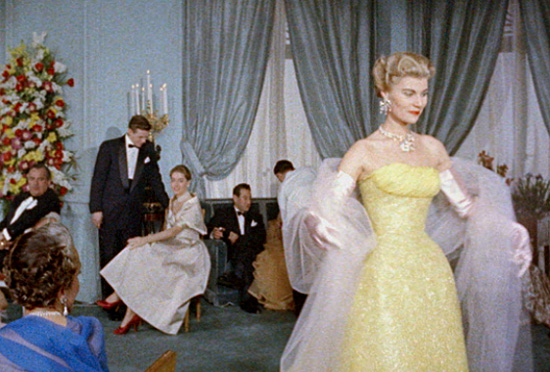 John
and Betty (with red shoes) in the back. Frame grab from "Cinerama Holiday".
Picture: Cinerama Inc. John
and Betty (with red shoes) in the back. Frame grab from "Cinerama Holiday".
Picture: Cinerama Inc.After dinner, everyone went into the drawing room for coffee or drinks and to watch some of the mannequins model a few things from the French collection. Notably, we saw pink and yellow used together twice. Once in a yellow lace gown worn with pink satin gloves and pink stole, and the other a pink satin gown with a yellow stole. These stoles were all floor-length. There was also a pale blue satin formal that buttoned down the front, a dress-coat ensemble of black dots on white silk, and then the accessories - which were shown on models wearing black silk tights - from floor to neck, black pumps, plenty of face make-up, and then the belts, jewelry and purses which they were showing. That ended the evening. Other Observations Shopping in a Paris department store is quite an experience and one that can take hours to find what you’re looking for. Some of the “magazins” occupy more than one building and you cross the streets and go from one to another. Inside they look like our capitol buildings, with large and usually decorative dome ceilings. One can stand on the first floor and look up seven floors to the dome. The other floors only circumvent the dome. To shop, you literally walk around in circles, and for miles. Sometimes we’d have the elevator operator refuse to take us upstairs and we’d have to ride the escalator or walk. One thing that is so apparent is the “dog-eat- dog” attitude among the people. There’s no such thing as politeness or consideration for a fellow human being - cars won’t slow down or stop even for a mother with a baby carriage, where in the States a person would screech to a halt & wave the person on Sunday is the Frenchman’s day. People literally fill the streets - the parks, the sidewalks. If there is spring in the air, it’s as if no one stayed at home. The thing here is to promenade. To see and be seen. |
|
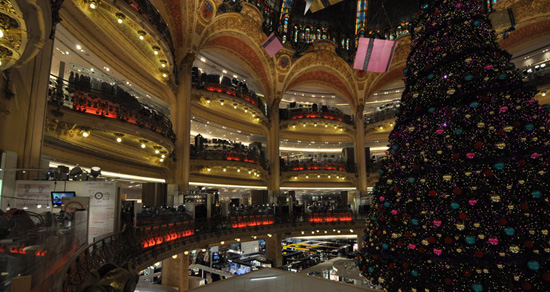 Gallerie La Fayette, Paris. Picture by Thomas Hauerslev Gallerie La Fayette, Paris. Picture by Thomas HauerslevPeople stroll slowly down the Champs Elysees from the Arche de Triomphe to the Place de la Concorde - and in all the little districts in Paris. They swarm to the Places and parks. Lovers in Paris are just that.They’ll sit and smooch on any park bench no matter how public, on the crowded metros, and walking down the streets. Since the average young man here doesn’t have, or have access, to a car, couples must carry on their lovemaking whenever and wherever there’s an opportunity. Movies are great places for this we’ve noticed is where the best entertainment may not be on the screen, but going on around you. Of course this is true in the U.S., but there it’s usually the young teenager - here it’s older ones - people in their twenties and thirties. One of the surprises in this country where you must pay or tip for everything is that you have to pay for the privilege of sitting on a park bench - from 5 to 20 francs per person. It may be because of this, that so much kissing goes on in the parks. The fellow probably feels he should get his money’s worth and therefore uses every minute. And the girls don’t seem to mind, and in some cases, are quite aggressive themselves. Now that spring is here, the parks are filled with children who play in the sandpiles, roll hoops, and sail their boats (a favorite sport) in the pools and fountains, and their boats are really something over here. School is out Thursday and Sunday, and on those days you can’t see the trees for the parents and children, for there you don’t take the kids for ride in the cars as at home, you take them to the park where there are balloon peddlers, ice cream and even pastry wagons, and goat-pulled carts. |
|
Chapter 4: Switzerland |
|
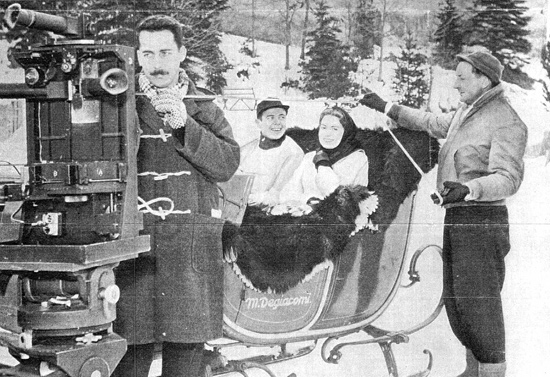 Filming
in Switzerland for. Tom Conroy to the left and the Marches in the sledge.
"Cinerama Holiday". Picture: Cinerama Inc. Filming
in Switzerland for. Tom Conroy to the left and the Marches in the sledge.
"Cinerama Holiday". Picture: Cinerama Inc.St. Moritz is a charming little town built on a hill overlooking a frozen lake which is often the scene of horse races. The inhabitants are friendly and jovial. We spent many hours going from one shop to another, acquainting ourselves with the merchandise and people. A workday in the shops starts about 8:00 and continues until a little past twelve, when most of the shops close for lunch, then an hour-and-a-half later open again and do business till 7:00 p.m. The Swiss are very industrious and always work a long day. When you go in a shop, the people are cordial even though you make no purchase and say “just looking.” Then when you start to leave, the clerk or clerks rush from behind the counter - and open the door for you with many friendly goodbyes, auf Wiedersehens. This makes one feel quite at home in short order. When we went shopping for our ski-clothes, we were told to bring several outfits so they’d have a choice of colors, styles, etc. for us. We went in the many stores and pointed to our picture on the cover of "Sie Und Er" as a means of explanation as to who we were, and then we picked out clothes. In most shops they didn’t even bother to check the veracity of our story. They just gave us the clothes and off we went. The Swiss are innately honest and expect you to be, too. The Carlton Hotel where we stayed was definitely in the luxury class, but despite this, was filled with friendly atmosphere, and eager-to-be-of-service employees. Here, as in Paris, the service charge is added automatically to your bill, eliminating the need to tip every time a bellboy brings you a letter, etc. However, it does not eliminate the headache of tipping when you leave - it only makes it worse because you’re not sure how little you can get by with. One thing more we found to be true, as in Paris, and which we’ve now concluded must be all over Europe, is the way anyone on the hotel staff enters your room without waiting for you to answer. It usually goes like this: They put the key in the lock and give one short rap - and then presto they’re in before you can say ‘yes’ or ‘no’ or ‘help.’ This is true of the chambermaid when she comes to clean, or bring laundry, the elevator boy who brings up letters or packages, and the thing is, they don’t just open the door, see you’re in bed and leave - Oh no. If they are bearing something, they walk clear across your room with it before they can leave it. It doesn’t seem to embarrass them and they probably figure it shouldn’t you. I suppose this following standard occurrence for tourists new to Europe, and, though we had been forewarned, we still made the mistake. In our Paris hotel room the first evening when it began to get dark, we went around pushing buttons to turn the lights on, and there were buttons everywhere. I pushed a button by one bed and lights went on so I pushed one on the other side, too. Nothing happened. A burnt out light bulb somewhere I reasoned until a few minutes later there was a rap on the door and there was a little maid. I gestured wildly, trying to explain we didn’t need anything and I was sorry, then I hit upon one French word that sounded familiar: Error. I said, “our error” and she smilingly backed from the room probably wishing this didn’t happen so often. After that, any button that I wasn’t sure about I didn’t push. |
|
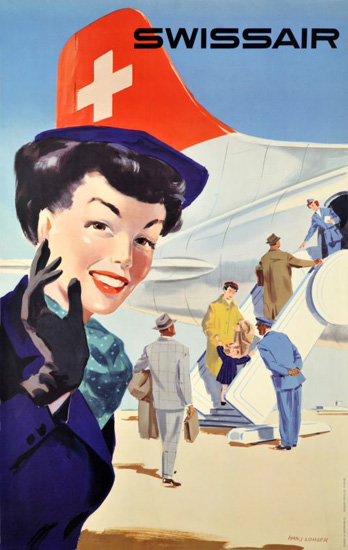 When we got to Switzerland, we had to go through a similar indoctrination to
find out which cords were for lights and which were for servants. We were
sure the cord by the tub was for the maid because there was always one by
the tub. And the cord by the bed we figured was the same, since there’s
always one by the bed - but the cord hanging from the door we weren’t sure
about. We could find no switch to turn the overhead lights on, yet this cord
looked just like all the others. It was a moment of tense excitement - me
huddled in bed and Johnny ready to grab a bathrobe, just in case. The mood
was like a ‘mellerdramer’ - Johnny pulled the cord - A light went on and we
burst into almost hysterical laughter - it was so funny, I doubt Edison was
as nervous the first time he got a light to light. But a friend of ours, Tom
Conroy, wasn’t so lucky. He pulled the cord by the tub, expecting a light to
go on “toute suite.” There was a maid wanting to be of service. They say
poor Tom nearly drowned diving in. When we got to Switzerland, we had to go through a similar indoctrination to
find out which cords were for lights and which were for servants. We were
sure the cord by the tub was for the maid because there was always one by
the tub. And the cord by the bed we figured was the same, since there’s
always one by the bed - but the cord hanging from the door we weren’t sure
about. We could find no switch to turn the overhead lights on, yet this cord
looked just like all the others. It was a moment of tense excitement - me
huddled in bed and Johnny ready to grab a bathrobe, just in case. The mood
was like a ‘mellerdramer’ - Johnny pulled the cord - A light went on and we
burst into almost hysterical laughter - it was so funny, I doubt Edison was
as nervous the first time he got a light to light. But a friend of ours, Tom
Conroy, wasn’t so lucky. He pulled the cord by the tub, expecting a light to
go on “toute suite.” There was a maid wanting to be of service. They say
poor Tom nearly drowned diving in.Swissair In talking to one of the stewardesses, I learned some amazing things about Swiss men, women and customs. It all began when I asked her why Swiss women didn’t shave their legs. Johnny and I had noted this many times - for on some woman it was daringly obvious - and it was most unattractive. But it’s all a part of being ‘natural’ which a Swiss woman is at all times. They also go very easy on makeup - lipstick suffices. She explained that though they like looking neat and attractive, they don’t want to be attractive to the point of being conspicuous. They are unhappy when people turn to take a second look. The idea is to pass unnoticed in a crowd. Men agree with this wholeheartedly. They want their women to attract as little attention as possible. One of the stewardesses, Ginotte, told me once she was engaged, her fiance would always insist she take her lipstick off. (I didn’t ask but he might have had an ulterior motive.) A Swiss girl doesn’t wear lipstick till she’s 18 or 20 and often waits till then for her first permanent. Another thing Ginotte explained was the strictness of her childhood. She came from a well-to-do family that has a summer and winter home. But despite this lack of pecuniary problems, her parents kept her and her brothers and sisters dressed in clothes more in keeping with what poorer children in their classes wore. They emphasized to children that clothes are not of prime importance in life but that what is in one’s head is. And the girls were kept in long straight braids till late teens. This opinion is echoed throughout Switzerland among upper class parents - I was rather astonished when I think of the United States where even in the grades a girl’s aim is to amass a collection of cashmere sweaters. Even though this conservatism is typical of all Switzerland, the women of this country, on the whole, are far better dressed and more fashionably too, than their neighbors in urban regions of France. The reason is the higher standard of living. Though clothes are expensive in comparison to the Swiss salaries, these same salaries are much larger than in France. A woman buys fewer clothes than an American, and expects to wear them longer, but they are smartly designed. In Zurich we saw more well-dressed women in a few hours than in 3 weeks in Paris. However to be well-dressed is not nearly as important to the European as it is to an American. In the States, women window shop, scan the fashion magazines for the latest dictates and always turn the conversation to clothes when they gather in numbers of two or more. In Europe (Switzerland at least), this is not so. The men pay no attention to a woman who is fashion-conscious or at least one that talks about it. If they catch the woman discussing such trivialities, they say, “Have you nothing more constructive to fill your minds with?” and promptly changes the conversation. Chesa Veglia In St. Moritz, we had many especially wonderful evenings. There were several very charming little restaurants. The Chesa Veglia was a large, centuries-old building with restaurants of different types on every floor and in different corners. Our favorite was the grill room where food was cooked over an open fire - and the meats, thus prepared, were divine. It was here that we took an American friend of ours, Bob Johnson, who came down from Germany to ski with us. We were having a wonderful time, eating the various courses, listening to music until dessert rolled around. Our friend - acting very blasé in the way of European cuisine - asked if we liked crepes suzettes. After having them once in Paris we decided once was enough. They were too strong for our taste. Oh no, Bob said, “They’re primo, tops, the greatest.” So he ordered them while we took a safer route and had fruit. About half-way through the first pancake - Bob began looking bleary-eyed and by the time he finished this same pancake he was almost drunk and decided to forgo the rest. I rather think he is a little wiser now. At last report I heard he’s given them up. Casper Badrutt One of the most unique meals we had was the night we took Bob out for fondue in a tiny little candle-lit restaurant where a wee orchestra accompanied a gypsy singer. The fondue was served in a large pottery casserole dish and placed in the middle of the table. We piled chunks of bread on our plates and dunked them one at a time in the goo by spearing them with a long fork. Meanwhile the waiter prepared the dressing for our salad by pouring salt, pepper, oil & vinegar into a flat plate and beating it with a fork. This done, he carefully poured it over our salad greens and tossed them till each leaf was coated. Then he stood by with an anxious look on his face till we tasted and beamed our satisfaction. We worked away at the fondue till it was down to the last bit in the bottom which we let bubble & brown and then ate. This is the best part of the fondue - the very last bit. Then Bob, John and I went to the little theater in town to see "The Story of Three Loves". The advertisements before the movie were very funny. Then the movie started and we became quite engrossed in it. Then, out of the blue, it stops - the lights go on and intermission music starts to play. This is so they can change reels. So everyone looks around, greets their friends, and by the time the movie starts again you’ve even forgotten what you are seeing. And naturally they interrupt in the most exciting parts. The view out our window at night was like a Christmas card scene. Snow everywhere, lights twinkling in windows and along the curving roads, and the sleigh bells jingling as the horse-drawn ‘taxis’ take people to and from the hotels, little taverns and clubs in town. At first I thought these were strictly for atmosphere, but soon learned they were really a necessity - as it’s quite difficult for cars to get around on slippery mountain streets. And it’s great fun, jogging along in the crisp mountain air with ski clothes on and fur blankets wrapped around you. For a ski instructor we had Rudolf „Rudi“ Rominger [1908-1979] - four times Olympic champion and a swell fellow. He started us out slowly and on short gentle slopes. The ski school was high on a mountain overlooking the town and lake. Nearby were two restaurants where you could also eat out in the blazing sunshine. The air in the mountains is so clean & fresh it just makes you feel wonderfully healthy all the time. Even though the temperature is very low, the dry air keeps it from being uncomfortable. And when you wear wool underwear and wool socks, wool-lined shoes and a sweater or two, you just don’t get cold very easily. However there was one thing this healthy Engadine air didn’t cure - and that was our wounds from our little train accident. We were enroute to St. Mortiz from Paris - it was in the morning and we went to the diner to get breakfast. They said they wouldn’t serve us, so we started back to our compartment. We suddenly came to the end of the train and we were pulling away from the other cars which had been left in the station. We instantly got panicky - no money with us or passports, and with Louis, Jr. and Mike running after us, waving their arms. What to do? Why, jump off of cause, which is what we did and fortunately lived to regret it. We ripped our hands, slacks and knees on the course rocks we landed on and limped back to the other train, with me sobbing hysterically. As soon as we got to St. Moritz, a doctor came to treat us. Wonderful Dr. Berry. He gave us penicillin to ward against infection and medicine for shock and put us to bed immediately. We limped around painfully for a good many days and had to postpone the start of our ski lessons till we recovered. We still have scars from the occasion. But we learned in having Dr. Berry, the great difference between Swiss & American Drs. In Switz, they are capable of treating all your ills & if you opt for an exam of one thing and they notice something else is wrong, they tell you and all for the same price. In the states, they do only what is asked, then usually have to refer you to someone else, with the bill getting larger all the time. We learned one thing - never to jump from a moving train no matter how slowly it seems to be going. |
|
Chapter 5: Italy |
|
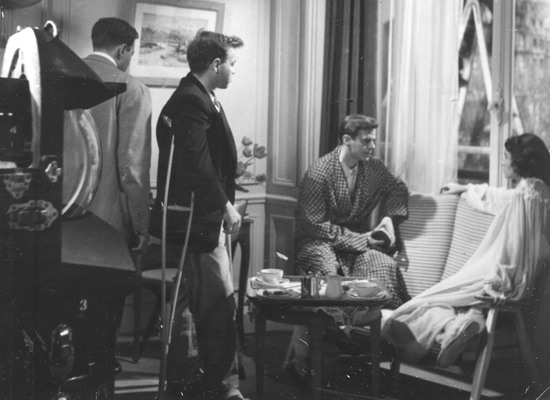 Filming
with Louis de Rochemont III (left)"Cinerama Holiday". Picture: Cinerama Inc. Filming
with Louis de Rochemont III (left)"Cinerama Holiday". Picture: Cinerama Inc.It was a case of love at first sight when we glimpsed Rome from the air. Everything looked so warm and green. It was only after we landed that we realized it was like June at home, though only March, with trees fully leafed out, flowers in bloom, and wisteria flowering in profuse and fragrant branches everywhere. It didn’t seem real when we passed the old Roman remains of aquaducts and walls. Though we’ve read about them in history books, it seemed unreal having them standing all around the city, and modern-day living going on all around them. When we drove through the gates at one of the entrances of the city, we almost expected Roman warriors to set out and question our right of way. The style of the houses and buildings were what we call “Spanish” in the States, thick plaster walls, squarely shaped, and all colorful in tone. Rome seemed like a tropical city in comparison to Paris. The sky was a brilliant blue, the buildings had a sun-baked look to them and the trees were very different from the northern ones. We saw lots of palm trees, poplars, olive (I think) and the funniest pine trees. They had a long trunk but the trees bushed out in a small round ball at the top rather than having an irregular conical shape. The first thing we did after dumping our stuff was to take a walk in the vicinity of the hotel. We noticed the Roman equivalent of the French “place” is the piazza of which there are many and every piazza has its own fountain, obelisk or monument of some sort. Fountains Rome has aplenty, our favorite being in Piazza Navona and Piazza Esedre, which is so beautiful at night, and the Piazza of the Spanish Steps. The first thing I wanted to find was the 7 hills of Rome, expecting them to be small mountains at least. Though you do have the impression Rome is hilly compared to Paris (which seems so flat) those famous 7 hills of old have been swallowed up by the city and are little more than mounds. Paris will always stick in my mind not as the city of light, the Chamber of Commerce name, but as the city in grey. But looking across the rooftops of Rome from the edge of the Borghese Gardens, one gets the impression of vivid Technicolor: orange, greens and white - and the flowers planted in park beds are some of the loveliest and most subtle colors I’ve seen, but usually bright yellows, purples, and crimsons. Paris, instead, is a city of gray and pastels. Pale green budding trees, pink and pale yellow tulips, pink blossoms in trees, and a bit of lavender and blue. We were anxiously awaiting our first taste of genuine Italian cooking, since one of our favorite specialties we make at home are pizza and spaghetti. We soon learned that there is more than one type of sauce and that Bolognese was what we had to ask for to get what resembles what we’ve always thought spaghetti should look like. We also were surprised to have to search for spaghetti on the menus, and then to find it listed as a first course, never as a meal in itself. But when we did find it and order it, it was usually delicious, as was the cannelloni, and ravioli, which became our favorites. Italian food was a surprise because it was much more varied than I’d ever expected and it was a refreshing change from months of French cooking. The flavors in French cooking are so subtle that no one flavor stands out, like ‘the whole is equal to the sum of its parts,” Italian cooking is more honest. If they use an ingredient, it’s not to be hidden, but to be tasted, and the flavors of tomatoes, oregano, basil, cheese, garlic, and even onions, are used a lot. Onions are what we missed most in Paris. Their onion soup is a farce as far as we’re concerned. I doubt they even drag an onion through it. It more resembles dark water than onion soup. But getting back to Rome, one pleasant surprise was the price of meals. Dinner for two hardly ever exceeds $10 even at the most expensive restaurant, and a terrific meal can be had for $3 a piece or less. The French equivalent would be easily twice as much. |
|
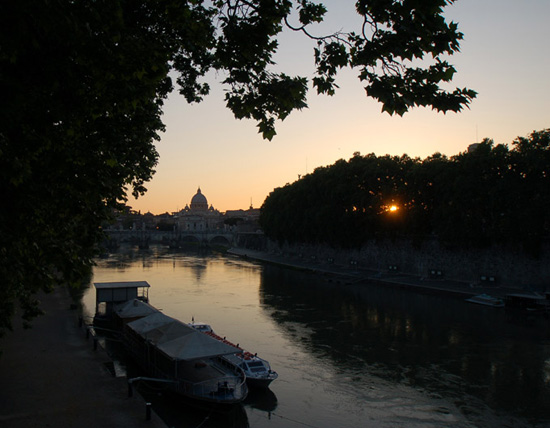 Rome. Picture by Thomas Hauerslev Rome. Picture by Thomas HauerslevWe missed not finding a taxi whenever you wish for one and also noticed when you do find one, they’re as slow as molasses in January compared to their French counterpart. We’re so used to tearing around Paris at 70 miles per hour that a more normal rate is boring. We did find that the percentage of English-speaking people is much higher here than France - which made it a lot easier to get around but also discovered more people trying to take us “for as much as they could get.” Being very short on time, we decided to take our first guided tour through Ancient Rome. Again we were amazed at the old and new being side-by-side. Even more astounding was new built on top of or inside of old Roman ruins. It seems people in a few centuries past took advantage of a good foundation when they saw it and using old bricks lying about, built homes, churches, offices on the old ruins. It hadn’t occurred to me before that Roman bricks, used so widely in modern homes and buildings, is really the same style used 2000 years ago in the Baths, Collisseum, Pantheon, etc. One evening as we were sitting on the Roman equivalent to the Champs Elysees (Via Veneto) sipping our drinks and watching beautiful Italian women and handsome men pass by, we were surprised to see a professor from KCU walk by. We stopped her and were surprised to find out she had read all about us in the Kansas City Star and knew who we were without our telling her. We had never met her before but had always called her “The Egyptian” because she fitted our concept of what an Egyptian would look like. We learned she is an Italian from Milan, coming from a very fine old family, and not Egyptian at all! We told her of our plans to attend the Opera that night and she told us what to expect from the audience if it didn’t like the performance. Sure enough, it was just as she had said. The people, whenever displeased with a performance or performer, would shout, hiss, boo - everything except throw tomatoes. I tried to imagine this happening in our Music Hall and had to laugh at the thought. The Italian does not repress his feelings and I felt very glad that I wasn’t on the stage facing this unhappy crowd. I was surprised at the number of children in the audience, actually enjoying the opera - this I’ve never seen in the States. We saw Ingrid Bergman there and she was very lovely and friendly when we spoke to her. |
|
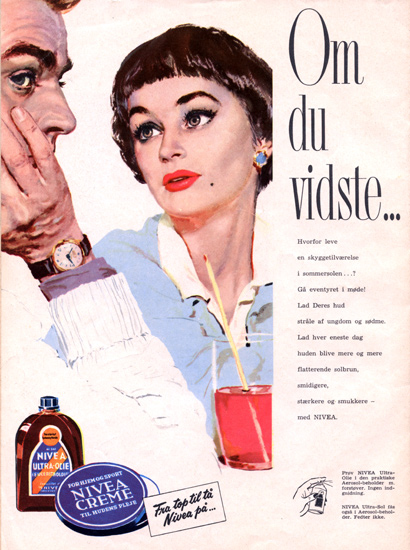 Danish
1954 advertisement for Nivea creme. Danish
1954 advertisement for Nivea creme.The shopping hours are just perfect as far as I’m concerned. They close from 1:30 to 4:00 p.m., giving the tourist time to eat, nap, or go sightseeing. Then at 4:00, they reopen and don’t close till 7:30 or 8:00 p.m. Every night seems like “downtown night.” The streets are filled with Romans visiting one another; the aperitif shops do a great business till 9:30 when people go home to a small dinner and bed. That is the social hour. Marie Costalamie (our Egyptian) took us into an old typical restaurant made famous by Mark Twain, who used to visit it and spend many hours there. There are pictures and even a bust of him there. We strolled down through the artistic colony Via Margretta - and window shopped on the Via Condotti. Since window shopping in the evening is a favorite pastime of mine, Johnny was worried about the travellers cheques. Any place else where I window shop he knows he’s safe because the stores are closed. Here, however, his money isn’t safe because I can buy as well as look. One of the most interesting restaurants I’ve ever seen was the Historia del Orso where Dante used to stay. Though the decor is not 100% authentic, they have preserved the general flavor of the Middle Ages, added some smart decorating ideas, and the result is very intriguing and pleasing. To coin a phrase, it’s loaded with ‘atmosphere.’ Our three days in Rome drew to a close and off we went to Naples en route to Capri. Here our first experience was seeing a huge castle (we don’t know whose) near the center of town, and from there we wound up the hill to our hotel, The Parker, where our room was something out of the Middle Ages, too. I think a bathroom, merely an afterthought, was built on the back with the oldest, noisiest most dilapidated plumbing I’d ever beheld. But after getting stuck $30 for two nights at The Hassler, we reveled in our little $5 room on the back with no view. We went to look up Bob Johnson’s friend to see if he could advise us on where to stay in Capri & discovered he lived 1 block from our hotel. He was very sweet, offered to let us stay there on our way back to Rome & gave us some reading material on Capri. The next morning we boarded a boat loaded with tourists of all nationalities and off we were to that oft-sung Isle of Capri. As we neared the harbor, I felt it was going to be disappointing. The sky was overcast, it was quite chilly and not too attractive, viewed from the boat. On the dock was a long line of uniformed porters from the various hotels and pensiones. We walked by them till we found the boy from Pensione Roberts. He told us where the car was & motioned us on while he got the bags. Between the boat & car, we were approached by at least a dozen offers of trips to the blue grotto, a dozen more carriage rides to Capri and Anna Capri, till it seemed as if we were walking a straight line, shaking our heads ‘no’ the whole time. On the ride up the hill, things began to look up, and when finally we saw our darling little pensione, brand new with a private balcony, and a view off the mariner piccolo side of the isle, all for $5 a night (including taxes & breakfast), we thought we were in heaven. After the hectic pace in Rome seeing all we could in a short time, the thought of strolling down narrow, winding lanes & lying on the beaches was all we wanted. We set out to explore the town of Capri, going in and out of shops, as is my favorite pastime, and getting an idea of the isle, its visitors and inhabitants. We found Americans in the minority among the many boatloads of people, most of them coming for a few hours only. We lost our self-consciousness about carrying two or three cameras around for we saw that Europeans, too, are camera fiends. It didn’t take me long to find out that the way to shop is to ask for what you want, give them your measurements, and the next morning it will be ready for you to wear at a price half that at home. We sat in the Piazza crowded with buses and tourists though the season had hardly begun and watched the parade go by. The contrast between the visitor and inhabitant is so striking. The natives are just that - still doing their farming, shoemaking, etc., with the most primitive of tools. They carry huge burdens on their heads, from baskets to beds and seldom seem to notice the tourists, other than to try & dodge them as they make their way. Once you do your business in a shop, they are your friends for life. They’ll cash your checks at good rates, loan you money if you need it, or give you your merchandise and let you pay later. They’ll suggest good places to eat, tell you where to buy something you’re looking for, and adopt you generally. The style of the island is complete informality. No one dresses for dinner (or looks out of place if he does) and any style goes. For a place so popular, it is amazing it is still so natural & un-commercialized. The little orange & lemon groves up the sides of the hills, the little flower and vegetable gardens, the style of the houses all are much as they’ve been for centuries. The names of the streets (which are often only narrow walks) are written on tiles and cemented into the corners of villas (houses), gate posts, and in walls and anything else that happens to be handy! Every house, no matter what its size, is a villa, and usually has a name. Villa …….. also on tile to prove it. To get to the beach, Marina Piccolo, is easy because it’s downhill all the way. Near the bottom you start encountering open-air restaurants - rooftop restaurants - and you sit overlooking other restaurants and the sea and cliffs. The food is usually superb - as is the case all over Italy, not prepared until you order it. And these restaurants are inexpensive - with the exception of the Canzone del Mare-Gracie Fields place, which is a little high but well worth it. One enters the grounds not at the beach but higher up the hill of walls, down through lovely landscaped gardens & paths to the free-form pool, built up higher than the beach & flanked on the side by little bathhouses. At the far end is the restaurant & night club, part of the tables out in the sun at the pool’s edge, others under a projecting roof and still others inside. Here you can sit & eat whether wearing a bathing suit or mink stole and enjoy a sumptuous & quite cosmopolitan meals served by waiters in tux and white dinner jackets. This is one thing we noticed in Europe. In even a tiny restaurant, the headwaiter or proprietor wears evening clothes - even at lunch time. Everything is quite formal and when they prepare a dish as much as possible is done right before your eyes. They never bring your plate from the kitchen with its portions of food already laid out. Instead, they usually bring out serving dishes, chafing dishes, etc. & serve your food from a small table pulled up alongside. Then there’s always a second helping if you want it. One night in Capri we went to the Gatto Bianco and were enjoying our pleasant dinner when we saw a couple I thought I knew. It turned out that the man, Milton Karp, was an engineer with the company doing Hall Brothers new buildings in Kansas City, and we had a great chat about the old place. They’re on an around-the-world trip - she’s a writer for the movies (or something) and will be in Hollywood this fall and will see us if we come out there to the premier of the movie we’re making. We walked up to the ruins of Tiberious Villa Jovia. It was extremely fascinating. Some of the tile walks were still intact. We purchased lots of Capri pants for me and even a choker of real pearls. Boy was I thrilled. They are of a pink luster & slightly baroque. Back in Naples Back in Naples we hired a horse-drawn carriage to take us to John Eastham’s place. Well, it took hours almost and then there was a torn up street and we had to walk the rest of the way with a little boy lugging our bags. But what a gorgeous evening when we did get there. We played all John’s records while he served dinner - Vermouth with a little white flower in it came first. Then consommé. Then steak and vegetables with Chianti. Then cheese and fruits, and finally some wonderful pastries and Asti Spumanti, a sweet almond-flavored sparkling wine - which John had cooled in a large pewter vase for a wine cooler. A thoroughly wonderful evening. Needless to say, we spent many hours eulogizing over the good old U.S. Visiting Europe is fun, but what would be so hard if we lived there would be the completely outmoded way they do everything. The general feeling is, if grandfather could do it this way, then it’s good enough for us. Farming methods are truly primitive in France and Italy. In Italy few homes, even those of the very wealthy, have heat. And the kitchens have only a tiny sink, cold water only and small ancient stoves. They seldom go to the trouble of heating water to do the dishes. |
|
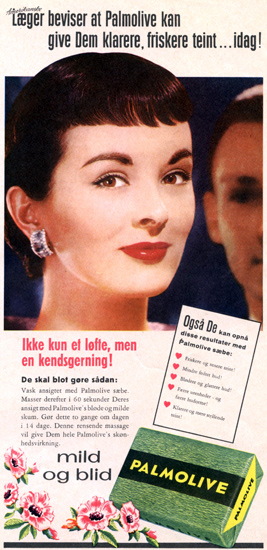 Danish
1954 advertisement for Palmolive hand soap. Danish
1954 advertisement for Palmolive hand soap.They huddle in cold rooms rather than part with their money for heating and even when they build new buildings, the electrical wiring runs along the walls to ceilings, rather than being built in where it won’t show. In Italy, which is largely Communist, they keep the people stirred up all the time against the Americans. This makes it tough on people living there. Their rent is fantastic just because they’re Americans. A GI never wears his uniform off base- it just isn’t safe. If he were to have an accident with a car - the Italians would tear him apart. But if he’s in cities, there’s always the chance he’s a tourist, and they’d never touch a tourist for they want the extra money that they bring in. The Italians are a hot-blooded, hot-tempered race, not at all resembling American Italians who hailed mainly from Sicily. There are many with fair skins and light eyes. As a whole, though quick to temper, they are friendly and happy. They sing in the streets and at their jobs, flirt openly with anyone that catches their eye, and talk loudly and voraciously to each other. In Naples you’d pull up to a stop sign and there’d be as many curious-looking horse-drawn vehicles there as cars. Maybe more. Every type of broken-down cart and nag that exists, and how it ties up traffic, is indescribable. When we started to board our train for home, we were furious to find that they sold us round trip tickets, good for three days only. So we had to fork over $10 more and bitterly went our way. It infuriated me the way they always almost everywhere in Europe try to take you for every cent they can get, by hook or crook. The way the check is padded, the huge service tip added on even when it isn’t deserved are all very unfair and disturbing to a freedom-loving American, who’d like to feel his own generosity is the standard when he tips! It is so costly traveling in Europe that people on a budget should never try it. Not only is a whopping 12-18% for service tacked on to a hotel bill, but you are expected to tip besides. Considering this amount is usually $1.75 a day, a lot of tipping could be done for that. Then if someone even helps you put a coat over your shoulder - another tip. What Europeans fail to realize is that tourists recommend to others and go back themselves to a place they were fairly treated, and would never go back to a place that “clipped” them. But money in the pocket now, rather than future business is what the Frenchman wants. On any subsequent trips to Europe - France will receive a minimum of time, and Paris scarcely a glance - unless we are considerably richer, yet Paris is a city of truly incomparable beauty when the sun shines on it. Her parks are lovely and filled with mothers and babies. But here again nothing is free. You must pay for your seat in the park. The boulevards and rues are lined with trees in neat, trimmed rows, and the chestnut trees with their large clusters of blossoms are beautiful. It is fun then to do nothing but walk slowly down the streets or sit in a park where the children play in sandpiles and roll their hoops along the paths or swing in funny swings, or ride in little carts pulled by goats. |
|
Chapter 6: Paris Again |
|
 New
2014 poster for the remastered version of "Cinerama Holiday". Cinerama Inc. New
2014 poster for the remastered version of "Cinerama Holiday". Cinerama Inc.Over all the Paris scenes stand Sacre Couer and the Tour Eiffel. Sacre Couer is a landmark for us and a sight we see out our windows. It is even reflected in our huge bathroom mirror, depending upon the moods of the weather. It is white against blue, dark grey clouds, or if a cloud is hiding it, it often appears dark grey against a milky white sky. We were told Parisians are quite angry at the building because it refuses to get dirty & grey like the rest of the city, but continues to gleam forth, a brilliant white ghost over the city. On nights when it is spotlighted it is especially beautiful from very near - and it seems even whiter than ever. It seems quite a coincidence that both Rome and Paris are plagued by owning one white building, (The Wedding Cake in Rome), and that inhabitants of both cities regret it. Giving Sacre Couer competition in height is ye old Eiffel Tower, a monster if there ever was one - gracefully shaped to be sure, but naked and cold in its bare self, as though it is waiting to be covered by something or other. However, after a slightly terrifying ride up it in which the elevator traveled a diagonal rather than vertical line, one receives as a reward a wonderful view of the city. And only from here does the Arche de Triomphe appear as large as it really is. It stands there, so big and square and solid. The eve of VE day anniversary, it was lit with three huge spotlights, red -white & blue, which played on a mammoth flag - over 20 yards long -that was hanging from the very center - suspended over the grave of France’s unknown soldier. The next day we saw General de Gaulle in a very brief parade, and got an idea of the number of police this city has, for they were at every street corner by the truck load, in case of riots - a few of which broke out. I’m sure 1 out of every 5 men in Paris must be a policeman. There are hundreds and thousands of them. Even a relatively small intersection can boast of having 3 or 4 and a large one even more. The thing we see which so amazes us, coming from a “mechanized” country, is that on every corner, a policeman must stand pushing buttons all day long to change the lights from red to green. It would be a simple matter to install an automatic device but I suppose this would cause unemployment & they think it smarter having an expensive crew of men doing the job instead. However, it seems to me a factory or two could employ the surplus and manufacture a few items to make life a little easier and more pleasant for the Frenchman and woman. There is one interesting thing we have learned about the French. Where another nationality will work together for a common cause, idea, or purpose - the Frenchman is bent on doing just what he personally wishes, and it makes little difference if another’s idea is better. He is too stubborn, too individualistic to change. We went to a most enlightening exhibition of household items at the huge Grand Palais, showing the very latest things. The washing machines were the most outdated complicated mechanisms I’ve ever witnessed. They were roller type, but I swear were not as good as the old Maytag my Grandmother has had for 15 years. The only time something really modern was shown, it was an American product. Hot water tanks are as big as a milk pail, and are attached to the wall above the tub or sink. Refrigerators are just plain tiny. We remembered how in Switzerland, our Swiss friends, even in their very modern apartments, have only tiny little built-in refrigerator. They don’t even keep these full. They never shop for more than one or two days and seldom do they like their things cold. One evening we were invited to a couple’s house for dinner- a dinner of cold cuts of meat, which we learned had been arranged earlier in the day and sitting out for hours on the cabinet. Not only were they not cold but of the five varieties there, only one was more was more than half-cooked or all were greasy with fat. All in all, we nearly starved. One thing we’ve gathered from our experience with European cooking is how each country’s style is strictly its own and seldom contains ideas borrowed from its neighbors. They never seem to think they can learn anything new by ‘plagiarizing’ from another country to add a new gist to their own foods. |
|
Chapter 7: The Trip Home |
|
|
On Thursday morning - just after learning the
night before we could go home on the Queen Mary, we were told they weren’t
sure. With just a few hours left to find out if & when, I went blithely off
to the hairdressers at Elizabeth Arden to get a long needed and wanted hair
styling. There I met Mrs. De Vandeuvre again who fixed things up for me in
fine style. While Johnny and I were in Paris we noticed that it seemed as if half the residents owned poodles, French poodles, of course. Even when people were dining out their poodle was with them, quietly lying at their feet as they ate, sipped wine, and smoked. That made me want one too, and what more appropriate souvenir of our stay could there be? We got the name of a kennel at the outskirts of the city and rode the Metro there. They had a litter of black miniature puppies about 6 weeks old, and we selected a female that kept pushing the others away so we would pet only her. Of course, it was a no-brainer: she was the one we wanted. We were leaving for home in just few days and they agreed to keep her until we left. In the meantime, Johnny determined we were going home and had them call NY to find out. He finished the packing, got Mimi and we were all set to go when I got back except Francois was still having trouble paying for the tickets. At last we set off for the boat train. Arrived just 1/2 minute before they closed the gates. We boarded the first car and hung out the window saying goodbye to Mike and Jim Petrie and Vladimir. Then Francois arrived to say goodbye to Charles who had been waiting at the other end of the train, and came up and handed me a dozen lovely pink roses. I was so excited I couldn’t believe it! Then the train started up, we waved our last goodbyes and clutching Mimi’s basket and the roses, walked through the train to car 5. Everyone wanted to play with Mimi. She caused quite a sensation. We sat next to a doctor and his wife from Chicago. After a while we had to go to the diner & eat. We drove through some beautiful countryside, lovelier than I’ve ever seen before. There are so many more trees than at home. Instead of fences, they use rows of trees to divide property. We arrived in Cherbourg a little after 8:00 p.m. and saw the Queen Mary docked adjacent to the railroad station. We stood by the train till all our luggage was assembled and then we boarded ship. We found our stateroom right away. It was quite a walk from the elevators, but quite large and almost luxurious. We didn’t even notice when the boat pulled away from the dock till we were way out in the harbor, being pulled by little tugs. 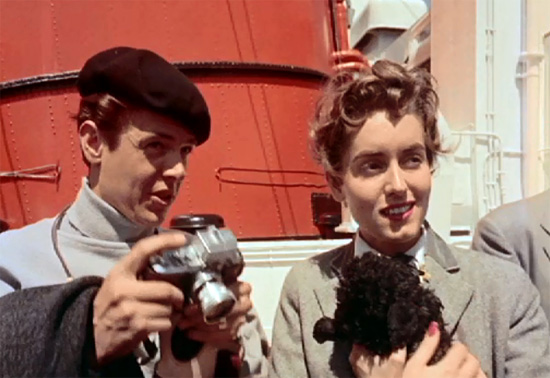 "I
had never seen that photo before of Johnny in his beret, and I with newly
shorn short locks holding tiny, precious Mimi or that one of me in my
fabulous designer Mauve silk chiffon peignoir and gown". Betty
York, 2016 "I
had never seen that photo before of Johnny in his beret, and I with newly
shorn short locks holding tiny, precious Mimi or that one of me in my
fabulous designer Mauve silk chiffon peignoir and gown". Betty
York, 2016Frame grab from "Cinerama Holiday". Picture: Cinerama Inc. We went up on the sundeck to watch this huge monster being dragged around by the tiny bug - like tugs. Spent the evening playing with Mimi. Finally went down to eat at 10:10 p.m. The kitchen was closed, but nonetheless they fixed us up with delicious sandwiches and a pear & cream cheese salad. So good. Then back to little Mimi who, poor thing, was starving to death. We were up off and on all night trying to keep her from making any noise. Johnny finally had to sleep with her - he said she wanted to play and not sleep. I couldn’t sleep for listening to the creaking of the walls as the boat rolled and each time it did, I mentally calculated the degrees. Friday morning we ordered breakfast - one of us always with Mimi in the bathroom while the steward was in the room. There we fed her some of our breakfast & took her to the kennels after which we explored the boat a bit. Looked in the shops to see what there was to buy & looked around till lunch time when we went down & had our first meal with the rest of the group. After lunch we went to see Mimi and then to the show Dangerous Mission. After this was over we chatted with Bruce & Joan - then barely enough time to change to evening things & off for cocktails in the Pursers cabin. After cocktails we went to dinner I didn’t feel too bad even though I didn’t have a formal on. After dinner we went to the lounge to play Bingo and the little Englishman (whom we had met) won and split the twelve-pound prize award with us. We all played bingo till 11:00 then they did some dancing. It was a grand evening. The champagne put me in a grand mood for sleeping which we did till 8:15 next morning. After those long, lovely and luxurious days at sea we docked in NY after passing the thrilling sight of the Statue of Liberty. We were home at last! We went up on the top deck after picking Mimi up at her kennel, to view our arrival. There was a camera crew recording our arrival and lots of familiar faces from the de Rochemont organization, and the Trollers, too. The biggest thrill was finally actually being in New York City at last. After hugs and kisses and greetings all around, we were taken to the Lexington Hotel which was just across the street from the Waldorf Astoria. No doubt they thought that hotel too ritzy for the "Typical Americans". We spent a few days shooting in NY at the Cinerama Theater where "This is Cinerama" was playing. We had gone to Saks pet department and bought a leather collar and leash for Mimi; pink for girls of course. We would tie her up at the back row while we and the Trollers were filmed entering the theater and walking down the aisles to our seats. Then more shots to record our reactions as the screen went from black and white to brilliant color and the curtains opened all the way out to show the huge curved Cinerama screen. The sound too, surrounded us from speakers that seemed to be everywhere. Finally we were finished and could at long last fly home to our eagerly waiting families and friends. Our Cinerama Holiday was over. Or was it? |
|
Epilogue |
|
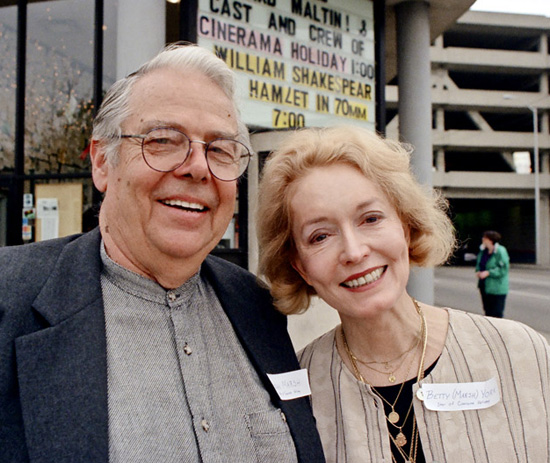 John
and Betty in Dayton, Ohio, May 1997 for the "Cinerama Holiday" reunion
party. Picture by Thomas Hauerslev John
and Betty in Dayton, Ohio, May 1997 for the "Cinerama Holiday" reunion
party. Picture by Thomas HauerslevJohnny went back to his dental practice, which he had sorely missed, where he was boss. No more waiting around for hours and days for weather to improve so scenes could be shot. I went back and joined my model friends in fashion shows, informal modelling and photography jobs, as if nothing unusual had happened. We used all the salary we had earned and which Mom Marsh had been receiving for us and we bought their darling Cape Cod style house in a suburb of KC only a mile from where he and his father had their dental office. We started turning the house into our home, working both inside and out. We both loved gardening and decorating and had plenty of room and ideas. I spent most of the summer scooting slowly across the lawn as I dealt fatal blows to all the crabgrass I could find. There was always an annual Home and Garden tour in KC where wealthy families' homes were so honored. We were invited to be on it that summer. After all, we really were celebrities of a sort thanks to all the press coverage we had received. It was a challenge but much fun too, getting ready for it. We had added a stockade fence in the back which shortened that area of the yard Against this backdrop I did planned plantings of pink and white flowers: tall in back, sloping down to a white alyssum border. Johnny turned the now hidden part into a vegetable garden, unselfishly planting my favorite fruits and veggies: marvelous tomatoes, beds of asparagus, Country Gentleman white corn on the cob, and a pyramid of everbearing strawberries. We both loved to garden. As for "Cinerama Holiday", when it premiered in NYC in the winter of 1955 we, as the "stars" were asked to attend. That was marvelous. Then as it gradually opened across the US we also attended those openings, always photographed and interviewed by the Press, TV, et al to help promote it. Those were heady experiences, but then we would go back to KC and return to being just plain Betty and John Marsh. • Go to Betty York, A Mini Bio • Go to Cinerama Afterglow - A Get Together in Dayton, OH • Go to California Zephyr and Cinerama Holiday • Go to Flicker Alley presents CINERAMA HOLIDAY |
|
| Go: back - top - back issues - news index Updated 21-01-24 |
